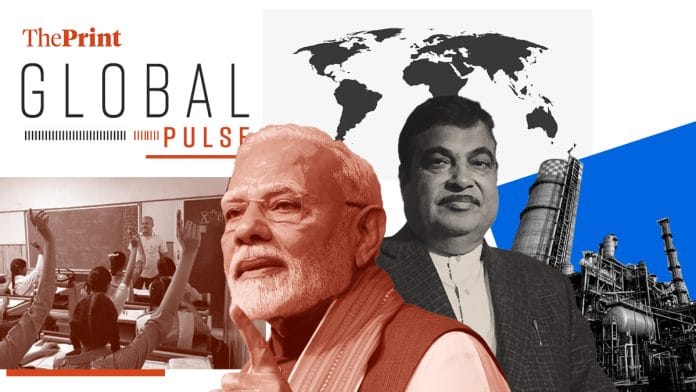New Delhi: Nitin Gadkari is the “outspoken maverick who could lead India”, according to The Economist.
In a glowing review billed as an ‘interview’, The Economist sat down with Gadkari in Nagpur after a day on the campaign trail and watched him take a “hard-earned slurp of his tea”. It then tells us that Gadkari went from being a rising star in the BJP to suddenly being removed from its parliamentary board amid tensions with Prime Minister Narendra Modi. But, despite this, the piece says, he is now “one of the candidates to succeed Mr Modi. And his chances may have just improved with American prosecutors’ allegations against Gautam Adani, Mr Modi’s closest business ally”.
The Adani scandal has tarnished Modi’s name further after the general election performance, the piece says, and offers an opportunity to Gadkari to now come out on top.
Though The Economist acknowledges that Gadkari is not Modi’s only potential successor, it dismisses Amit Shah and Yogi Adityanath as possible challengers citing different reasons. Shah is seen as too close to Modi and therefore painted with the same brush, while Adityanath is seen as too controversial. The piece also makes clear that Gadkari would be the RSS pick—especially as he echoes the RSS line against Modi’s “divisive oratory”. The RSS is his “life’s conviction”, he tells The Economist.
The most telling part of the interview comes early on in a comment that The Economist recognises as a dig against Modi: “No one is perfect and no one can claim that he is perfect,” said Gadkari. “We need to establish a good atmosphere between the parties and between people who have different types of ideology.”
The piece paints him as a versatile politician who has had the wits to weather many a storm. He demurs when asked if he has prime ministerial ambitions. He tells The Economist that he’s happy doing his work and harbours no such aspirations. No one from his party is going to ask him to be prime minister either, he says “with a chuckle”.
“Endurance is not the only key to Indian politics. A bit of media savvy helps too,” the piece finishes. Clearly Gadkari’s media savvy worked in this instance.
The Financial Times echoes a recent Wall Street Journal story from this week in an opinion by the Asia Editor, Robin Harding: India can achieve its industrialisation dreams, but only if the government gets out of its own way first.
The op-ed paints a quick picture of India’s economic landscape, boiling it down to debt and underdevelopment. The Modi government has tackled the latter by investing heavily in infrastructure.
“Macroeconomically, India is now in good shape,” the piece says. “With equity markets strong, credit available and an enormous tailwind from India’s youthful demographics, there are no obvious constraints. Slow investment is about micro, not macro; about desire, not ability.”
But China still casts a long shadow over the region, and countries like Bangladesh and Vietnam have experienced manufacturing success and export-led growth, leaving India far behind. And Indian industrialists “face many hurdles”—the government favours large companies and advanced industries, leaving smaller industrialists unsupported in the margins.
Exporting is also difficult. The Modi government might be trying to foster the domestic output of goods, but it also makes India less competitive. India also has few free trade deals with wealthy economies, but it’s competing with countries that that have been able to climb the supply chain through free trade deals with Western countries.
“The good news is that much of the hardest work has been done,” the op-ed ends. “Many of the obstacles to Indian industry do not require big expenditures or the most painful reforms; they mainly involve getting out of the way so the dynamism of India’s young entrepreneurs can shine through. Do that, and ‘Made in India’ can become as ubiquitous as ‘Made in China’ is today.”
The comparisons with China just don’t end. The Economist has another story on how the route to universal education has had profoundly different impacts on development in India and China—which might explain how “China became the world’s factory, which turbocharged growth” and “India became its back office”.
While China took a bottom-up approach to schooling, India took a top-down approach by supporting universities at the expense of primary schools. What that meant is by 1980, 93 percent of Chinese children were enrolled in primary schools compared to 69 per cent in India, and only 1.7 percent enrolled in college compared to 8 percent in India.
“All this created different labour forces as their economies liberalised,” the piece explains, unpacking a study done by researchers Nitin Kumar Bharti and Li Yang at the Paris School of Economics. “In 1988 around 60% of Indian adults were illiterate compared with 22% in China. That hindered Indians from moving out of agriculture into more lucrative jobs. It also lowered their productivity. In addition, China’s higher share of engineering and vocational graduates, combined with more widespread primary schooling, helped its manufacturing sector thrive. India’s relative advantage in tertiary education made it more suitable for services-led growth,” it said.
India has tried to fix these issues since then, but it might be too late. Many economists fear that the era of manufacturing-led growth is now a bygone dream. The piece ends with a sad statistic that explains the current state of affairs, with too many highly educated Indians jostling for too few jobs—of the 1.5 million engineering students who will graduate this year, only 10 percent are expected to land a job.
Also read: AI’s role in shaping India’s future & how spate of exam paper leaks is a sign of deeper problems






